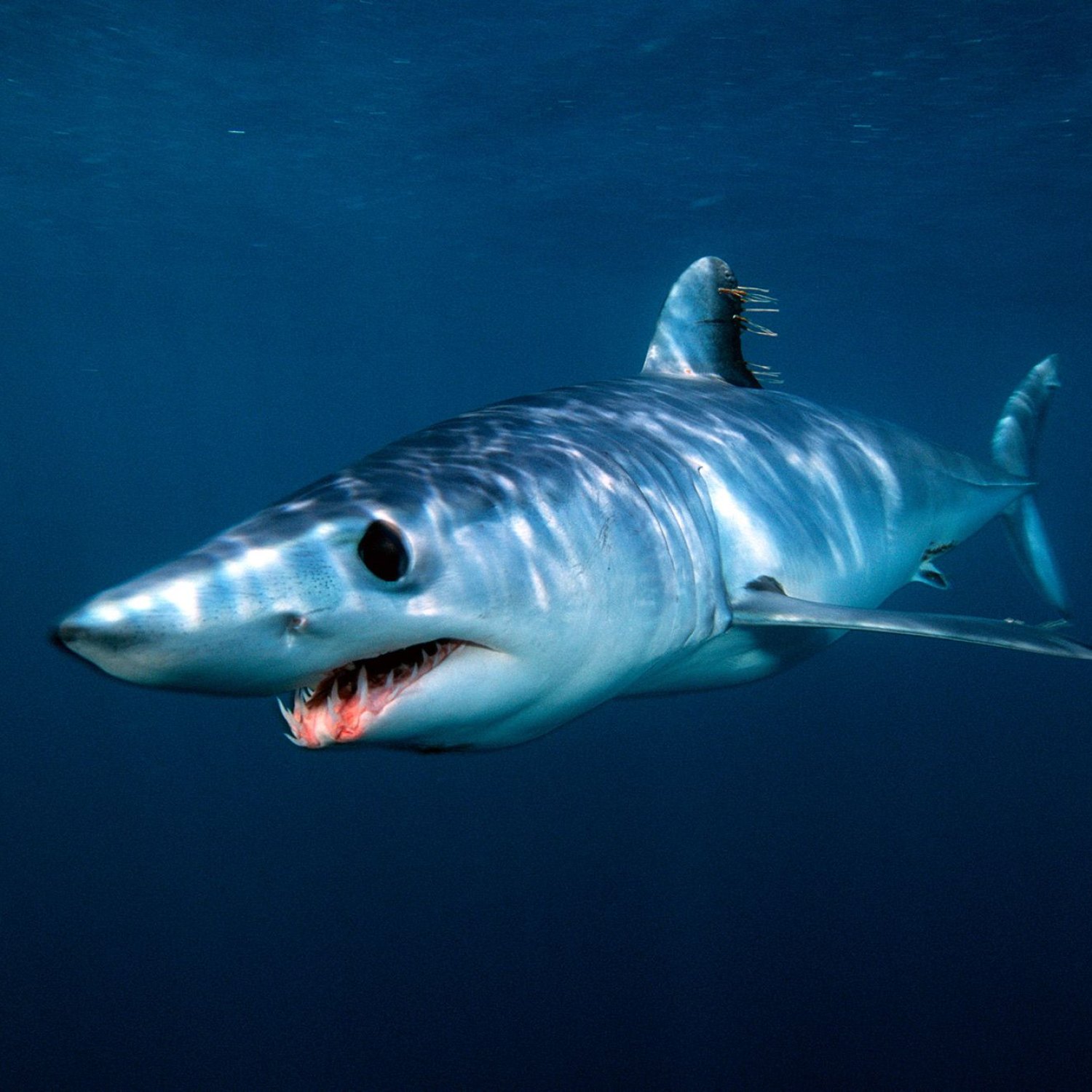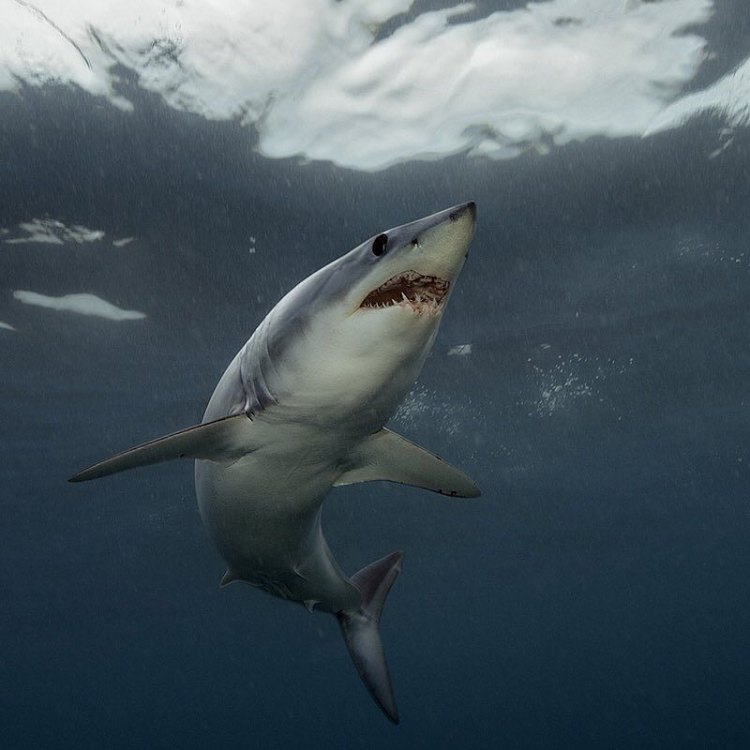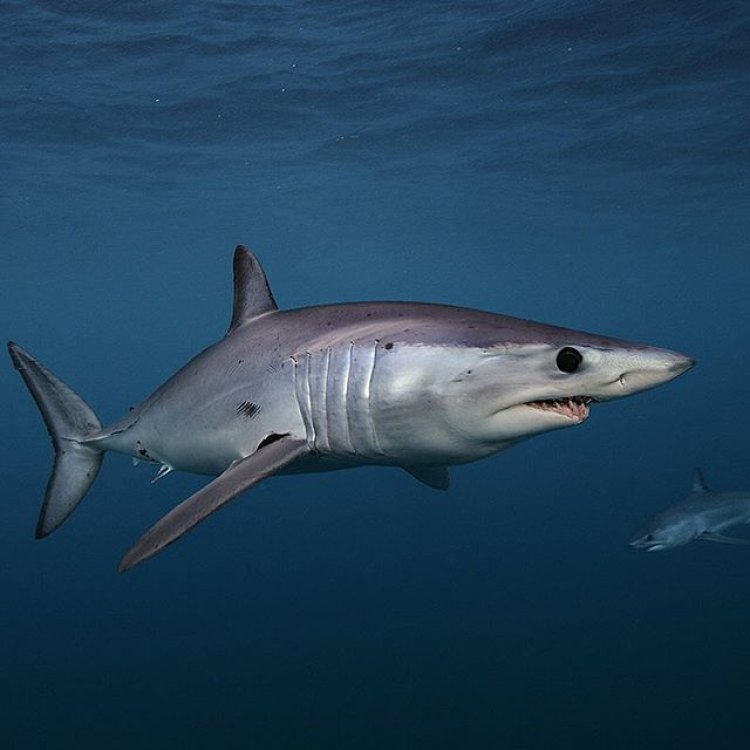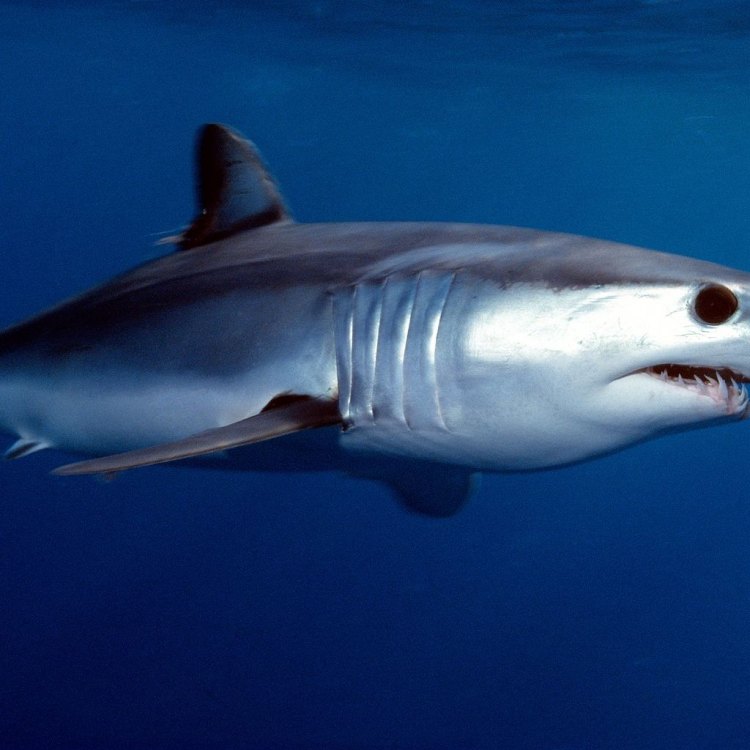
Shortfin Mako Shark
Up to 12 feet (3.8 meters)
The Shortfin Mako Shark is a stunning creature found in the open ocean. With a length of up to 12 feet, it is the fastest shark in the world, reaching speeds of over 60 miles per hour. Its streamlined and torpedo-shaped body, belonging to the Lamnidae family, allows it to glide effortlessly through the water. Keep an eye out for this impressive animal on your next deep-sea adventure! #ShortfinMakoShark #OceanLife #SpeedySwimmer
Animal Details Summary:
Common Name: Shortfin Mako Shark
Kingdom: Animalia
Habitat: Pelagic and offshore waters
A Fascinating Look into the Shortfin Mako Shark: The Speed Demon of the Open Sea
It's no surprise that the ocean is full of mysterious and fascinating creatures. From the tiniest fish to the largest whales, the diversity of marine life never ceases to amaze us. However, among all the creatures that inhabit our oceans, there is one that stands out for its unique characteristics and abilities - the Shortfin Mako Shark.But what makes this shark so special? Is it its speed, its incredible size, or its impressive hunting techniques? In this article, we will dive into the world of the Shortfin Mako Shark, exploring its physical traits, behavior, and distribution, and uncovering what makes it one of the most intriguing and awe-inspiring sharks in the sea Shortfin Mako Shark.
The Basics: Scientific Classification and Physical Traits
The Shortfin Mako Shark, also known by its scientific name Isurus oxyrinchus, belongs to the Animalia Kingdom and the Chordata Phylum. It is classified under the Chondrichthyes Class, which includes all cartilaginous fish such as sharks, rays, and skates. Within this class, the Shortfin Mako Shark belongs to the Lamniformes Order, and the Lamnidae Family, alongside other shark species such as Great Whites and Porbeagles.But what truly makes the Shortfin Mako Shark stand out is its physical traits. With a streamlined and torpedo-shaped body, this shark is built for speed. Its elongated and pointed snout, sharp teeth, and powerful jaw make it a top predator in the open ocean. It also has large, dark, and round eyes that give it excellent vision, allowing it to spot prey from far away and strike with precision.
The Shortfin Mako Shark's coloration is also noteworthy. It has a deep blue color on its dorsal side, making it nearly invisible from above when swimming in the deep ocean Skipjack Tuna. On the other hand, its ventral side is white, which helps it blend in with the sunlight filtering from above, making it almost invisible to prey looking upwards. This unique coloration, along with its streamlined body, makes it a master of stealth in the water.
The Need for Speed: Adaptation for Hunting
One of the most impressive characteristics of the Shortfin Mako Shark is its speed, making it one of the fastest sharks in the sea. It has been known to reach incredible speeds of up to 60 miles per hour (96.5 km/h), earning it the nickname "the cheetah of the sea." This exceptional speed is achieved by its efficient swimming technique, with a back and forth motion rather than the side-to-side movement seen in other sharks.So why does the Shortfin Mako Shark need to be so fast? The answer is simple - it's a top predator, and its prey can also move at incredible speeds. Its primary diet consists of pelagic and offshore fish, such as tuna and swordfish, that also have impressive agility and speed in the water. To catch these swift prey, the Shortfin Mako Shark has evolved to be a speed demon, using its streamlined body and powerful tail to accelerate quickly and catch up to its prey.
However, this adaptation for hunting also has its disadvantages. The Shortfin Mako Shark's need for speed comes at a cost, as it must continuously swim to breathe. It cannot stay still for long periods like other sharks, and if it stops swimming, it will suffocate and sink to the ocean floor. This makes it an obligate ram ventilator, meaning it must constantly swim to force water over its gills for oxygen intake.
An Open-Ocean Dweller: Habitat and Distribution
As its name suggests, the Shortfin Mako Shark has a short fin, which helps it maneuver and turn quickly, aiding its high-speed hunting. This feature, however, also limits its ability to swim for long periods and navigate through shallow waters. As a result, this shark is usually found in the open ocean, away from the coastline, and in deeper waters that offer enough space for its incredible speed.The Shortfin Mako Shark has a global distribution, found in all temperate and tropical oceans worldwide. It can be spotted in both the northern and southern hemispheres, inhabiting waters in the Atlantic, Pacific, and Indian Oceans. However, it is worth noting that this shark is a migratory species, and its movements also depend on water temperature and food availability.
A Bloodthirsty Hunter: Feeding Methods
Being a carnivore, the Shortfin Mako Shark has a voracious appetite, and it's not afraid to chase its prey at high speeds, relying on its incredible physical abilities to catch it. It has a varied diet, including a wide range of fish, squid, and even other smaller sharks. It has also been known to hunt sea birds, such as albatross, as they rest on the surface of the water.To capture its prey, the Shortfin Mako Shark uses its speed, agility, and sharp teeth. It approaches its prey from below, gaining momentum before launching a surprise attack, using its teeth to inflict deep puncture wounds. But what's even more impressive is its ability to jump out of the water, performing incredible acrobatics before landing back in the ocean with its prey in its mouth.
Facing Threats: Conservation Concerns
The Shortfin Mako Shark's exceptional speed and sharp skills have made it a prized catch among commercial and recreational fishermen. The demand for its meat and fins, used for shark fin soup, has led to a severe decline in its population in recent years. Its long gestation period and low reproductive rate also make it susceptible to overfishing, putting it on the list of vulnerable species according to the International Union for Conservation of Nature (IUCN).To address this issue, governments and organizations around the world have implemented conservation measures, such as catch limits and bans on shark finning. However, more action needs to be taken to ensure the survival of this magnificent shark species.
The Shortfin Mako Shark: A Marvel of Nature
In conclusion, the Shortfin Mako Shark is undoubtedly a remarkable species, with its incredible speed, physical adaptations, and global distribution. It is a top predator in the open ocean, showcasing the best of what nature has to offer. However, it also faces significant threats from human activities, and it is up to us to protect and preserve this magnificent creature for future generations to come. So, the next time you spot a sleek and torpedo-shaped shark slicing through the water, don't be surprised if it's a Shortfin Mako Shark - the speed demon of the open sea.

Shortfin Mako Shark
Animal Details Shortfin Mako Shark - Scientific Name: Isurus oxyrinchus
- Category: Animals S
- Scientific Name: Isurus oxyrinchus
- Common Name: Shortfin Mako Shark
- Kingdom: Animalia
- Phylum: Chordata
- Class: Chondrichthyes
- Order: Lamniformes
- Family: Lamnidae
- Habitat: Pelagic and offshore waters
- Feeding Method: Carnivorous
- Geographical Distribution: Worldwide in tropical and temperate oceans
- Country of Origin: Global distribution
- Location: Open ocean
- Animal Coloration: Deep blue on the dorsal side, white on the ventral side
- Body Shape: Streamlined and torpedo-shaped
- Length: Up to 12 feet (3.8 meters)

Shortfin Mako Shark
- Adult Size: Up to 14 feet (4.3 meters)
- Average Lifespan: About 25 years
- Reproduction: Ovoviviparous
- Reproductive Behavior: Mating occurs through internal fertilization
- Sound or Call: Not known to produce sounds or calls
- Migration Pattern: Long-distance migrations
- Social Groups: Generally solitary
- Behavior: Active and fast-swimming
- Threats: Overfishing, bycatch, habitat destruction
- Conservation Status: Vulnerable
- Impact on Ecosystem: Apex predator, helps maintain balance in marine ecosystems
- Human Use: Commercial and recreational fishing
- Distinctive Features: Long, slim body with a prominent dorsal fin and large, dark eyes
- Interesting Facts: Fastest shark species, capable of reaching speeds up to 45 mph (72 km/h)
- Predator: Orcas and larger sharks

Isurus oxyrinchus
The Incredible Shortfin Mako Shark: The Fastest Shark in the Sea
Sharks have long been a subject of fascination and fear for humans. With their powerful jaws and sharp teeth, they are often portrayed as ruthless predators. But not all sharks fit this stereotype. One of the most interesting and unique species of shark is the shortfin mako shark PeaceOfAnimals.Com.The shortfin mako shark, also known as the blue pointer or bonito shark, is a large, swift, and powerful shark that inhabits the open waters of the world's oceans. It belongs to the same family as other well-known sharks such as the great white and tiger shark, but it has its own unique characteristics that set it apart.
Let's take a deep dive into the fascinating world of the shortfin mako shark and uncover the interesting facts and features that make it one of the most incredible creatures of the sea.
An Impressive Size
Firstly, the shortfin mako shark is a large shark that can grow up to 14 feet (4.3 meters) in length, making it one of the top predators in the ocean. This impressive size is due to its long, slim body, which is designed for speed and agility. However, the average size of a shortfin mako shark is around 10 feet (3 meters) for males and 11 feet (3.3 meters) for females.Its body is built for speed, with a streamlined shape and a powerful caudal (tail) fin Spanish Mackerel. This allows the mako shark to reach incredible speeds in the water, making it one of the fastest sharks in the ocean.
Average Lifespan: About 25 Years
The average lifespan of a shortfin mako shark is around 25 years, although some individuals may live longer. Like most sharks, they have a slow growth rate and reach sexual maturity at around 8-11 years of age.However, their long lifespan is threatened by various human activities, which we will discuss in detail later in the article.
Unique Reproduction
One of the most fascinating aspects of the shortfin mako shark is its reproduction process. Mako sharks are ovoviviparous, which means that they give birth to live young. This is different from most sharks, which are either oviparous (lay eggs) or viviparous (give birth to live young).But what sets the shortfin mako shark's reproductive process apart is that it is also an internal fertilization process. This means that the female shark's eggs are fertilized internally by the male before they develop into live young inside her body.
This unique reproductive behavior ensures that the young mako sharks have a higher chance of survival compared to other shark species.
Mating Behavior
Mating in shortfin mako sharks occurs during the summer months, and it is a rather aggressive process. The males and females engage in a courtship dance, with the male biting the female's fins and body until she is ready to mate. Once the female is ready, the male inserts his claspers (external reproductive organs) into the female's cloaca (genital opening) to fertilize her eggs.After fertilization, the female shark’s body will produce a special protein that surrounds the fertilized eggs, allowing them to develop into live young. The gestation period for shortfin mako sharks is around 15-18 months, and females can give birth to 4-18 pups at a time.
Not Known for Making Sounds
Unlike some other shark species, shortfin mako sharks are not known to produce sounds or calls. They are rather silent creatures, and scientists believe that this is due to their hunting style. Being an active and fast-swimming shark, they do not rely on sound to locate their prey, but instead use their excellent vision and sense of smell.However, research has shown that they may be able to produce sounds in some situations, such as during courtship and mating. Further studies are needed to confirm this interesting finding.
Long-Distance Migrations
Shortfin mako sharks are known for their long-distance migrations, which can span thousands of miles. They are highly migratory and move through different ocean regions, following their prey and seeking warmer waters.They have been observed making migrations from the East Coast of the United States all the way to the Mediterranean Sea, and have even been spotted in the equatorial waters of the Pacific Ocean.
But these long migrations make them vulnerable to various threats, as their movement patterns can bring them into contact with human activities.
Solitary Creatures
Shortfin mako sharks are generally solitary creatures, meaning they prefer to live and hunt alone. They are territorial animals and can be aggressive towards other sharks, often engaging in fights over food or mates.However, they have been observed forming temporary schools or groups during their long migrations, possibly for protection or finding mates. But once they reach their destination, they disperse and return to their solitary lifestyle.
Active and Fast Swimming
As mentioned earlier, the shortfin mako shark is known for its incredible speed in the water. They are active and agile predators, capable of reaching speeds of up to 45 mph (72 km/h). This makes them the fastest shark species and one of the fastest creatures in the ocean.Their speed is a result of their streamlined body, powerful muscles, and tail fin, which allows them to propel themselves through the water with great force and precision. They can also jump out of the water, reaching heights of up to 20 feet (6 meters), an impressive feat considering their size.
This speed and agility make them efficient hunters, allowing them to catch fast-moving prey such as tuna, swordfish, and other smaller sharks.
Threats to the Shortfin Mako Shark
Unfortunately, despite its impressive attributes, the shortfin mako shark is facing various threats that are putting its population at risk. The biggest threat to mako sharks is overfishing, with commercial and recreational fishing being the main culprits.Mako sharks are highly prized for their meat, fins, and liver oil, making them a valuable catch for fishermen. They are often caught and targeted intentionally, but they can also fall victim to bycatch, where they are caught unintentionally in fishing nets and gear.
Apart from overfishing, the destruction of mako shark habitats, such as coral reefs and open ocean areas, also poses a threat to their survival. Destruction of their habitat can limit their food sources and disrupt their migration patterns, affecting their population and reproduction.
These threats have greatly reduced the number of shortfin mako sharks, with their population declining by 60-70% in some parts of the world. This has led to their conservation status being classified as "vulnerable" by the International Union for Conservation of Nature (IUCN).
The Impact on the Ecosystem
The shortfin mako shark is considered an apex predator, meaning it is at the top of the food chain in its ocean environment. As such, it plays a crucial role in maintaining the balance of marine ecosystems.Being a predator of fast-moving fish species, the mako shark helps control their population and prevents them from overgrazing on other marine organisms, thus ensuring the health and diversity of the ocean ecosystem. By keeping other species in check, the mako shark helps maintain a healthy balance in the ocean.
Therefore, the decline in mako shark populations can have a ripple effect on the entire marine ecosystem, leading to imbalances and potential impacts on other species that depend on the ocean for survival.
Human Use of Shortfin Mako Sharks
Humans have been using shortfin mako sharks for various purposes for centuries. Historically, mako sharks have been used for their meat and oil, which is believed to have medicinal properties. They were also considered a game fish, with recreational fishermen targeting them as a trophy catch.Today, mako sharks are still used for their meat and oil, although their market value has decreased due to concerns over their declining population. However, there is still a demand for their fins, which are used in traditional dishes such as shark fin soup.
Distinctive Features
The shortfin mako shark has some distinctive features that make it stand out from other shark species. Its most defining feature is its long, slim body, which is designed for speed and agility. It also has a prominent dorsal fin, along with two smaller fins near its tail, giving it a sleek and aerodynamic appearance.They also have large, dark eyes that help them spot their prey in the open water, as well as a pointed snout and large mouth filled with sharp teeth.
But perhaps the most remarkable feature of the shortfin mako shark is its striking coloration. The upper part of its body is a beautiful shade of metallic blue, while its underside is white, allowing it to blend into its surroundings and ambush its prey.
Interesting Facts about the Shortfin Mako Shark
Apart from its unique features, the shortfin mako shark also has several interesting facts that are worth mentioning. Here are some fascinating facts about this incredible shark:- Though mako sharks are known to be solitary creatures, they have been observed swimming in pairs or groups of up to 30 individuals during their migrations. This behavior is also seen during mating.
- Mako sharks have a body temperature that is 7-10 degrees warmer than the surrounding water, allowing them to swim in colder waters and maintain their speed.
- Shortfin mako sharks are not

A Fascinating Look into the Shortfin Mako Shark: The Speed Demon of the Open Sea
Disclaimer: The content provided is for informational purposes only. We cannot guarantee the accuracy of the information on this page 100%. All information provided here may change without prior notice.












